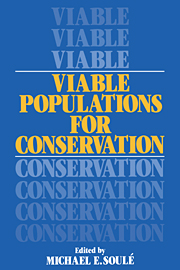Book contents
- Frontmatter
- Contents
- List of contributors
- Preface
- 1 Introduction
- 2 The demography of chance extinction
- 3 Extinction models and mammalian persistence
- 4 Minimum viable population size in the presence of catastrophes
- 5 Minimum viable populations: coping with uncertainty
- 6 Effective population size, genetic variation, and their use in population management
- 7 Spatial structure and population vulnerability
- 8 Managing critically endangered species: the Sumatran rhino as a case study
- 9 The role of interagency cooperation in managing for viable populations
- 10 Where do we go from here?
- Index
- Frontmatter
- Contents
- List of contributors
- Preface
- 1 Introduction
- 2 The demography of chance extinction
- 3 Extinction models and mammalian persistence
- 4 Minimum viable population size in the presence of catastrophes
- 5 Minimum viable populations: coping with uncertainty
- 6 Effective population size, genetic variation, and their use in population management
- 7 Spatial structure and population vulnerability
- 8 Managing critically endangered species: the Sumatran rhino as a case study
- 9 The role of interagency cooperation in managing for viable populations
- 10 Where do we go from here?
- Index
Summary
As the biosphere retreats in the face of physically superior forces, some conservation biologists are tempted to employ emotive rhetoric in the defense of ecological and species diversity, believing that such utterances will inspire others to join in their cause. Such a tactic may not be appropriate in a volume directed at managers and scholars, so let me only say that the subject of this book is central to conservation and conservation biology. It is also distinguished by its intellectual challenge.
The ‘viable population problem’ is very young. As documented in Chapter 1, it is only in the last decade or so that its importance has become recognized and its complexity appreciated. Herein we describe the significant advances that have already occurred. Our purpose is to spur increased interest in this aspect of conservation biology.
The logic of this volume is accretionary. Chapter 1 describes the viable population issue, examines its history, and warns of its complexity. In Chapter 2, Daniel Goodman provides the first of several major elements — a theory of persistence based on population dynamics, especially the interaction of environmental variability and the rate of population growth. He shows how it is possible to directly estimate the likelihood of persistence.
- Type
- Chapter
- Information
- Viable Populations for Conservation , pp. xi - xiiPublisher: Cambridge University PressPrint publication year: 1987



